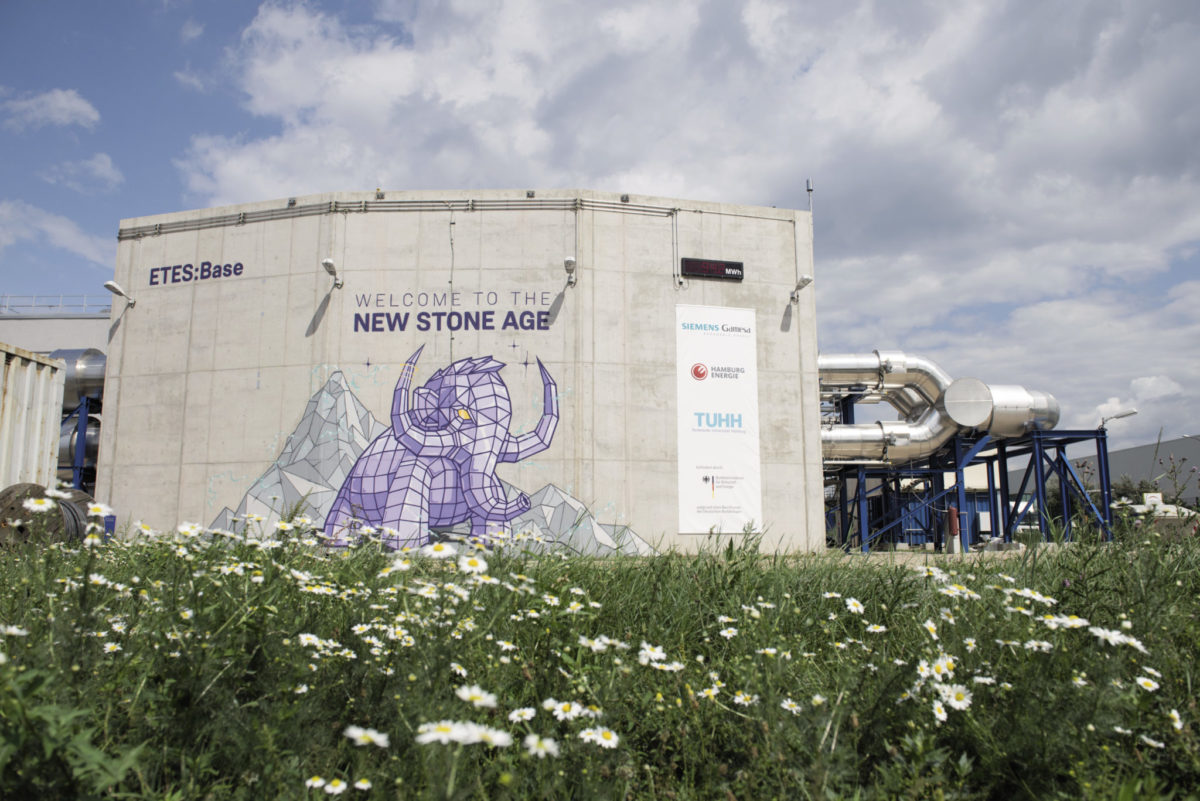From pv magazine 08/2021
Energy storage remains one of the great challenges of the 2020s, as the uptake of renewables, the cheapest and most sustainable form of electricity generation, continues to become standard.
A default approach to store these intermittent sources of energy, though, is less clear. Long-duration storage continues to require a longer duration for economic viability and market presence. Battery storage dominates thinking now, while the possibility of hydrogen as a viable solution of the future is a goal, but not yet a reality.
Thermal energy storage (TES) offers a decarbonization path, and electro-thermal storage offers clear benefits of high energy density and longer duration. Despite the sense that it will be an indispensable part of the overall storage market, particularly with the potential delivery of heating, and even cooling, commercialization is slow.
Path to ignition
The estimated future market for thermal energy storage shows billions are on the table to support renewables. The International Renewable Energy Agency (IRENA) estimates a 2027 global market of $10.1 billion. In its November 2020 report, IRENA noted that the global market for TES could triple in size by 2030, with more than 800 GWh installed, up from 234 GWh of total capacity installed in 2019, mostly in solar tower and concentrated solar power molten salt installations. IRENA also noted that technological developments could “unlock rapid growth in TES deployment.”
Raymond Decorvet, a senior account executive at MAN Energy Solutions (MAN ES) in Switzerland, told pv magazine that insufficient investment is being made across the board in energy storage, including TES. Naturally, that puts a ceiling on new ideas, innovations, and concepts.
“Everybody is now investing in PV or wind. We already have a surplus of power in the Nordics. We are paying constraint payments – we all know this.” said Decorvet.
“Why is there not investment in power storage? The most damaging problem facing power production today is the shortage of storage. Big investment in storage today will be the winner when the golden nuggets of early PV and wind are gone. It can’t be batteries – they are just not sustainable in my eyes. Completely sustainable options, that last 50 years, are a must.”
In Europe, the major grid operations – categorized as distribution system operators (DSOs) and transmission system operators (TSOs) – aren’t allowed to build storage other than battery energy storage systems (BESS) under current rules. That withholds significant investment in alternative storage options.
“Any other good storage, more sustainable storage, is not allowed to be built. The question is, why?” questioned Decorvet. “We need politicians in Brussels to build more than just batteries. If investors are still trying to invest in PV or wind, and aren’t already in, those new investors will place second. If they invest in storage, their time will come. TSOs and DSOs will love it: You can integrate, sell, and then finally, when policies change, even sell the storage to the grid operators. They will pay for it. If I was an investor, I would invest in storage.”
Hot competition
Jonas Eklind is the CEO of Azelio, a Swedish Stirling engine manufacturer that turned its focus to TES solutions in 2016. Eklind believes the best design for long-duration storage is thermal.
“The basic idea that I had, and the company had, was to create long-duration energy storage for dispatchable renewable energy, and an optimized solution for daily cycling. To do that, the best design for long duration is a thermal energy storage system.”
Eklind, a former CEO of Swedish battery maker Nilar, said that the problem with battery storage is duration and scale.
“You cannot combine batteries to add duration because of the cost,” he explained. “If you double duration [of storage], you double the cost. Triple duration, triple the cost. That’s completely different to thermal storage.”
With sustained electricity generation from TES solutions, the cost of storage is said to be “extremely lower cost” when compared with batteries. Yet, batteries currently dominate the storage market.
Prototype to development
Early TES industry players are progressing from pilot and proof-of-concept designs towards full commercial developments and agreements.
MAN ETES: MAN ES developed a utility-scale electro-thermal energy storage (ETES) system in collaboration with ABB Switzerland, running at comparatively lower temperatures to provide trigeneration: the simultaneous storage, use and distribution of electricity, heat and cold.
Using MAN’s existing competencies with turbomachinery, including compressors and heat exchangers, the system stores electrical energy as both heat at up to 150°C, and as cold in isolated tanks, using CO2 as the medium. The system generates electricity during a discharging cycle, while stored heat and cold can both be used in industrial applications. The system has a coefficient of performance (COP) of three, and is applicable to utility-scale sizes, with the standard configuration storing 128 MWh of electrical power.
With the base electrical regeneration, and varying requirements for heat and cold depending on the desired industry use case, the suggested cost of the range of MAN ETES configurations range from “€10 million to between the €30-40 million range,” said Decorvet.
The company won its first significant project in Esbjerg, Denmark. The MAN ETES system will replace a coal-fired CHP for district heating. Two heat pumps will provide overall heating capacity of 50 MW, with an emissions-free approach, using renewable power from nearby wind farms and seawater as a heat source. The system will be the largest heat pump in the world using CO2 as the refrigerant.
Decorvet confirmed that the system will be commissioned within the second half of 2023, with approximate costs for the Esbjerg municipal utility, DIN Forsyning, to end up somewhere around “the top of the range.”
Azelio: Azelio booked its first commercial project in Dubai in March 2021, installing its first TES system, known as TES.POD, to provide storage for 300 kW of solar PV.
The system stores heat in aluminum up to 600°C, liquefied within a container. Azelio’s Stirling engines convert the heat to electricity and can provide industrial heating at between 55°C and 65°C, at a duration of 13 hours.
A further project in Sweden was announced in March, providing storage for a 446 kW rooftop solar PV installation, along with providing industrial heat.
Jonas Eklind explained that the system is completely modular, with each module providing 13 kW of electrical output, with the company scoping out projects between 100 kW and 100 MW.
“You can connect as many modules as you need and then you connect them in clusters, so you can connect eight of them [for 100 kW], you can connect 800, or you can connect 2,000 modules, to give you the power level that you need. We can build any size from 100 kW, and larger – any multiple of 13 kW” said Eklind.
“And if you want 1 MW, you will always get the duration of 13 hours for 1 MW. So the electrical output is approximately 13 MWh from the 1 MW, and a 10 MW will give you 130 MWh, and so on.”
Azelio cites a 59% cheaper LCOE than diesel generators and 31% cheaper than BESS.

Industry growth
Other players across different markets continue to develop their own TES systems, hoping to turn pilots into large-scale programs.
Siemens Gamesa commissioned a trial project in Hamburg, Germany, in 2019, with 30 MW of nominal power, storing 130 MWh of energy for up to one week within 1,000 tons of Norwegian volcanic rock. Electricity is converted to hot air, and blown onto the rock, reaching temperatures of 750°C. The project has attracted subsequent interest, with Siemens Gamesa quoting €40-50/MWh long-duration thermal energy storage cost, and more installations planned. The system remains operational.
Berlin-based Lumenion installed its novel steel block TES in 2018. A first 450 kWh prototype installed at the University of Applied Sciences (HTW) in Berlin was followed by a 2.4 MWh system for district power and local heating supply system, and operated by Vattenfall. The company plans to develop systems up to 500 MWh. The steel block can be heated to temperatures as high as 650°C or above, as required.
In Australia, 1414 Degrees commenced a journey towards a molten silicon TES solution, opting towards a much higher phase change material operating temperature of 1,414°C. Following pilot testing, the company announced in 2020 that its proprietary TES system (known as TESS) would require additional development work to be “commercially robust.” Its next pilot is now planned for 2023.
Malta, a company spun out of Alphabet’s moonshot factory, X, raised $50 million in funding, on top of a previous round of $26 million held in 2018. Malta aims to store electrical energy in molten salts and cold liquid. It’s aiming for its first commercial project to be online in 2024-25.
This content is protected by copyright and may not be reused. If you want to cooperate with us and would like to reuse some of our content, please contact: editors@pv-magazine.com.









1 comment
By submitting this form you agree to pv magazine using your data for the purposes of publishing your comment.
Your personal data will only be disclosed or otherwise transmitted to third parties for the purposes of spam filtering or if this is necessary for technical maintenance of the website. Any other transfer to third parties will not take place unless this is justified on the basis of applicable data protection regulations or if pv magazine is legally obliged to do so.
You may revoke this consent at any time with effect for the future, in which case your personal data will be deleted immediately. Otherwise, your data will be deleted if pv magazine has processed your request or the purpose of data storage is fulfilled.
Further information on data privacy can be found in our Data Protection Policy.